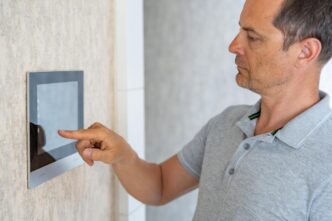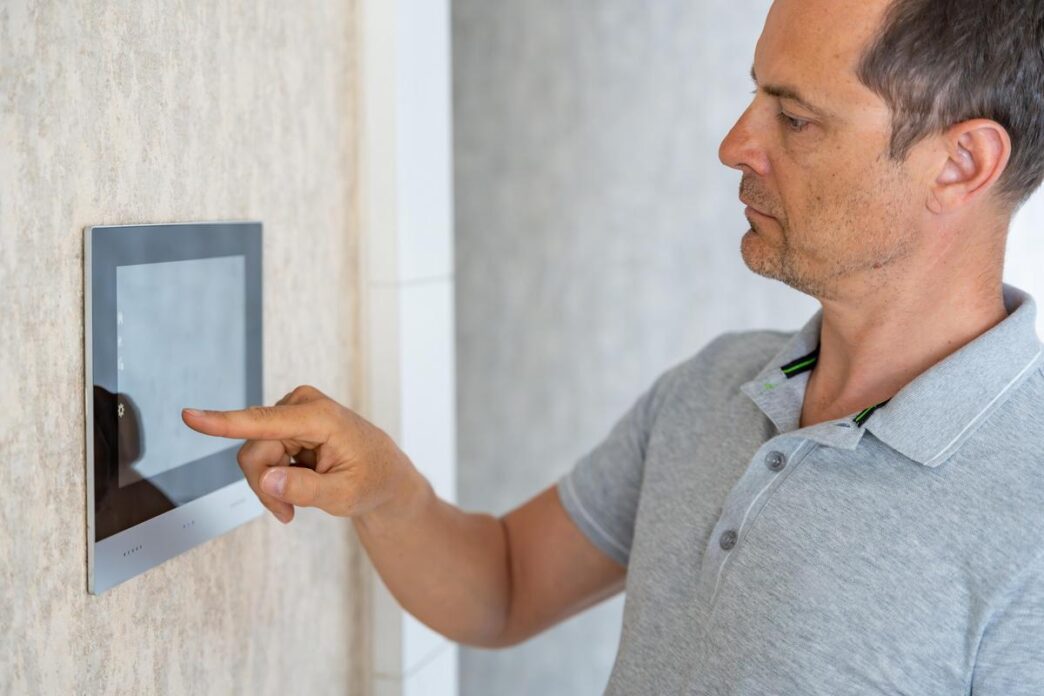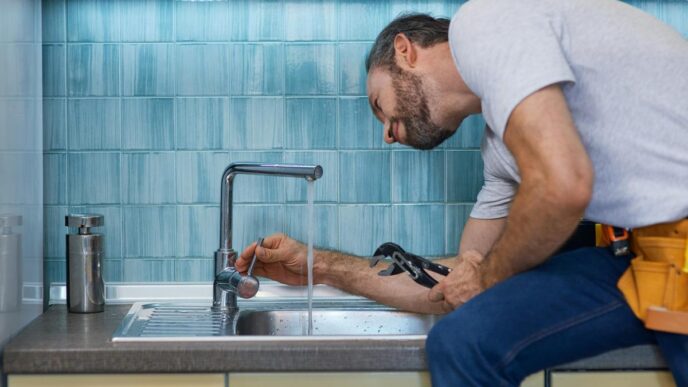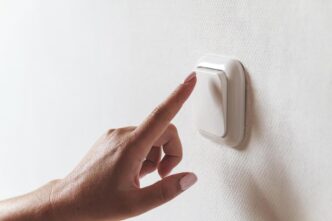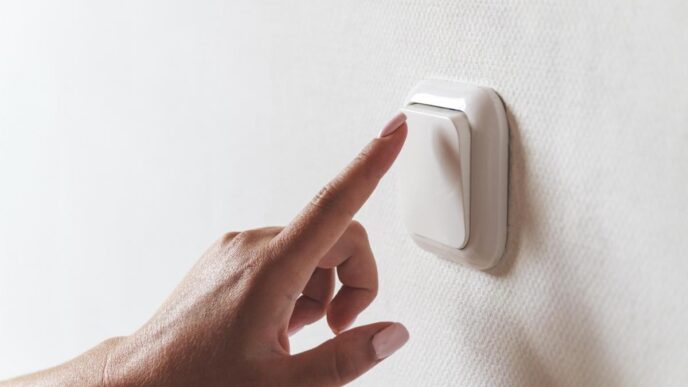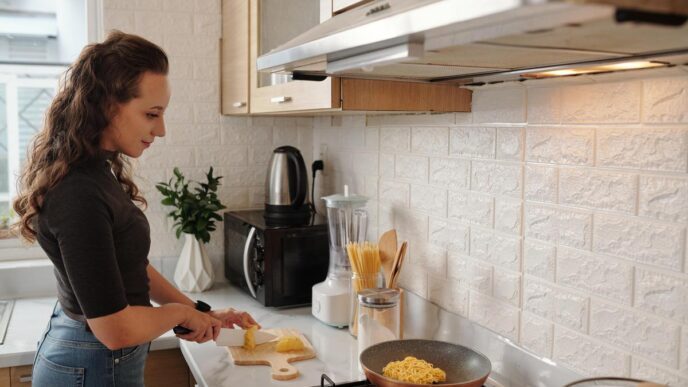Key Takeaways:
- DIY security systems are cost-effective and easy to install with basic tools (e.g., screwdriver, drill).
- Start with essential components: motion detectors, entry sensors, audible alarms, and security cameras.
- Affordable systems include SimpliSafe and Ring Alarm kits, offering monitoring features and easy setup.
- To minimize costs, opt for basic features and consider solar-powered outdoor cameras.
- DIY systems like SimpliSafe and Ring avoid professional installation fees, offering flexibility and customization.
- Insurance companies may offer discounts of 2%-5% for homes with security systems.
- Budget-friendly smart home devices enhance security without high costs; options include SimpliSafe and Ring systems.
- Wireless systems are portable and easier to install compared to wired setups.
- Expandable systems allow for future upgrades without overspending initially.
Ready to secure your home without emptying your wallet? I've cracked the code for installing a home security system on a budget! Learn the tools you'll need, explore affordable options, and choose the best DIY setup for your needs. Don't spend a fortune; ensure your family's safety with cost-effective solutions. Dive into my step-by-step guide and discover how you can perfectly balance security and spending. Let's get started!
How Can You Install a Home Security System on a Budget?
When you're looking to secure your home without spending too much, DIY systems can be the perfect solution. You don't always need professionals for installation. Instead, with the right tools and equipment, you can set it up yourself.
What tools and equipment do you need for installation?
To get started, first gather some basic tools like a screwdriver, drill, level, and measuring tape. You also need a reliable internet connection if your system is wireless. These simple tools help you place cameras and sensors quickly. Some systems come with sticky pads or small nails, while others might need more sturdy anchoring. Make sure you have these tools ready, which helps avoid unexpected costs or delays.
Step-by-step guide for setting up a DIY security system
Installing a home security system doesn’t have to be difficult. Let's tackle this step-by-step. Begin by planning your security layout. Figure out which areas need monitoring first, like entry doors and windows. Install sensors on these doors and windows where needed. The instructions should guide you on placement specifics. For cameras, choose corners inside your home that give clear views of each room. Outside, position cameras to cover driveways and entrances.
Next, focus on setting up the control panel if your system includes one. The control panel acts like a brain for the system. Connect it to your Wi-Fi to enable notifications and remote access. If you have a doorbell camera or solar lights, attach them near doorways and walking paths for added security. They catch intruders before they even approach your home.
How to minimize costs during installation
Reducing installation costs is crucial if you are on a budget. Choose basic systems that offer flexibility. Systems like the SimpliSafe 8-Piece Wireless Home Security System and the Ring Alarm 5-Piece Kit are affordable. Both offer professional monitoring at a lower price. The SimpliSafe system is easy to install and doesn’t require mounting equipment. With the first month of monitoring free, you can decide if the service is worth it moving forward.
Another tip to save costs is to limit the number of premium features. While some systems offer advanced monitoring, focusing on basic features can keep costs down. Install solar-powered cameras like the SOVMIKU CG6 solar camera for an affordable outdoor solution. This camera connects wirelessly and needs no complex installation.
For apartment dwellers or those renting, try the GRSICO Wi-Fi Alarm System. It caters to smaller spaces and avoids drilling, making it rental-friendly. Furthermore, simple tricks like adding a dog bowl or building neighbor relationships can enhance security without extra spending.
Finally, think about potential insurance discounts. Many companies offer discounts for homes with security systems. You might save between 2% and 5% on your insurance, which helps offset the cost over time. By following these steps, you can set up an effective home security system without breaking the bank.
What Are the Most Affordable Home Security Options?
When thinking about home security, expensive systems might come to mind. But you don't need to spend much to stay safe. There are affordable home security options that can keep your home secure.
Top Affordable Security Systems Under $300
First, let's look at some top-rated budget-friendly security systems available for under $300.
-
SimpliSafe 8-Piece Wireless Home Security System: This system costs between $167 and $239.99. It has a 4.6-star rating and offers professional monitoring for $19.99 per month, with the first month free. This system is easy to set up and offers reliable protection.
-
Ring Alarm 5-Piece Kit: Priced at $199.99, it has a 4.7-star rating. It allows self-monitoring, with optional professional monitoring at $20 per month. The system is compatible with other Ring devices for a more comprehensive setup.
-
SOVMIKU CG6 Solar-Powered Camera: Ideal for outdoor use, this camera retails for about $39.99. It features a 2K camera with motion detection and two-way audio. The solar power makes it eco-friendly and cost-effective.
-
GRSICO Wi-Fi Alarm System: This nine-piece kit costs $79.99. It's suitable for apartments or rentals and expands to include up to 20 sensors. It supports smart assistants like Alexa and Siri, making it a versatile choice.
-
MIHANI Solar Lights: These are priced between $33.99 and $39.99. They provide outdoor lighting with a motion detector. These lights deter intruders and are energy-efficient.
Budget-Friendly vs. High-End Systems
Now, what's the difference between budget-friendly and high-end systems? High-end systems come with more advanced features such as integrated smart home technology, high-resolution cameras, and 24/7 monitoring. Budget systems, on the other hand, provide basic security features at lower costs, often with the option for upgrades.
Features That Matter in Low-Cost Systems
In low-cost systems, certain features are crucial. Look for systems with motion detection, door and window sensors, and reliable cameras. The ability to upgrade or expand your system over time is also important. Many budget systems now offer integration with smart home devices, allowing you to control everything from one app.
In choosing the best DIY home security system, ensure you consider what coverage your home needs most. A well-thought-out security setup can deter potential intruders and give you peace of mind. You don't have to spend much to protect your home, thanks to advancements in affordable security tech. Consider DIY home security systems for an option that balances cost and functionality.
How Do You Choose the Right Security System for Your Home?
When choosing the right security system, start with your home’s needs. Walk around your home and check for weak spots. Are there many windows? Do you need outdoor cameras? Knowing your home’s layout helps you decide what is necessary.
Consider the size of your home and your family’s lifestyle. A bigger home may need more sensors. If you travel often, a system with remote access could be ideal. Think about whether you prefer a self-monitoring or a professionally monitored system. Self-monitoring is cheaper but requires more personal effort.
Next, prioritize features that are most vital. Focus on features that protect your home best, like door and window sensors. Add-ons such as smoke detectors and cameras are essential too. Some systems, like SimpliSafe, provide good basics at a low cost. SimpliSafe offers a system with professional monitoring for under $300, making it an excellent choice for budget-conscious buyers.
Affordability is crucial if you're on a budget. You don't have to spend a lot to get good protection. Many affordable security systems offer great features. The Ring Alarm System, for example, provides quality and allows for self-monitoring, which saves money.
When you know which features matter most, it helps to maximize those features while staying within budget. Balance your wants with what you can afford. You can add smart features later. Even if starting simple, make sure the system can expand with your needs.
Think about the cost over time, not just the upfront price. Some systems have hidden fees like monthly subscriptions. A solar-powered camera is a good alternative for outdoor monitoring because it saves on electricity bills.
For renters, portability is key. Some systems, like the GRSICO Wi-Fi Alarm System, are ideal for places where you may not stay forever. It's smart to choose systems that work with your existing devices, like phones and smart assistants. This way, you won't need extra equipment.
Lastly, remember that a security system can save you money on home insurance. You might get a discount from your insurance company. Check with providers like Allstate and State Farm to see how much you could save. Usually, security systems can lower your premium by 2% to 5%.
Thinking through these factors makes choosing a home security system easier and more effective. Protect your home smartly without emptying your wallet.
Are There DIY Home Security Installation Options?
DIY home security systems are easy to install and kind to your wallet. No need for a pro to come set up; you can do it yourself. This means you save money on setup fees and have control over the whole process.
Benefits of DIY Systems vs. Professional Installation
DIY systems offer significant savings and flexibility. First, you avoid costly installation charges from a professional service. When you set up your own system, you choose where each component goes. This allows greater customization and a better fit for your home. Plus, many DIY home security systems have wireless features, so you don’t need to deal with wires.
Which DIY Systems Are Easiest to Install?
Not all DIY systems are the same, but many are easy to set up. Some top-rated systems like SimpliSafe and Ring Alarm are known for their simplicity. SimpliSafe, for example, has peel-and-stick sensors and clear instructions. You just stick them on doors or windows, and they are ready. Ring Alarm offers a similar setup with easy placement and no wiring. These systems are designed for people with no technical background.
Common Mistakes to Avoid in DIY Installations
When you start installing, a few mistakes are common. First, placing sensors too far from the hub can limit their range. Ensure sensors are within the range suggested in the manual. Second, not securing cameras can lead to problems. Make sure cameras are mounted securely and cover key areas like front doors or paths. Also, forgetting to test the system before completing the setup is a mistake. Always perform a test run for cameras and sensors to know all parts work well.
For example, with a Ring Alarm, follow the included guide to avoid mishaps. Simple checks can save time and ensure your system protects effectively.
DIY home security systems simplify making your home safe. Why pay more when you can do a secure setup yourself? Find a system that fits your needs, install carefully, and enjoy peace of mind without spending a fortune.
What Basic Security System Components Are Essential?
When protecting your home, knowing what you need is crucial. There are several basic security system components that you cannot ignore. First, consider motion detectors. They are effective for interior and exterior monitoring. These devices detect unusual movement and can alert you immediately. They are simple yet vital for any security setup.
Next, entry sensors are indispensable. These sensors monitor doors and windows, sending alerts if tampered with. A basic setup usually includes at least a couple of these. For budget constraints, you can start with main entry points and expand gradually.
An audible alarm is another key component. When paired with motion detectors or entry sensors, the alarm serves as a powerful deterrent. It not only alerts you but can also scare off potential intruders. Loud is good, but balance is important so as not to disrupt neighbors often.
A security camera provides visual monitoring. Even a single camera can be useful. Place it at main entry points for the best return on investment. Choose cameras with night vision and motion detection to keep an eye on things day and night. Look for affordable models that offer clear images and are durable.
Enhancing these basics adds another layer of security. Consider smart locks for ease of access and added safety. They can integrate with your smartphone, giving you control from anywhere. They are slightly more expensive but save hassle in the long run.
Video doorbells can be a great addition, offering both camera functions and the ability to communicate with visitors remotely. These are cost-effective for monitoring front doors and are getting more affordable with advances in technology.
Balancing essential parts with advanced options depends on your priorities. If you're tech-savvy, integrating a smart home system offers flexibility and extra features. For instance, linking cameras and alarms to your phone can bring peace of mind while you're away.
Remember, advanced options carry additional costs, so identify what matters most to you. Maybe start simple, then upgrade as your budget allows. Often, basic components are enough, deterring most threats effectively.
An entry-level security system can be surprisingly affordable. Options like the SimpliSafe 8-Piece System or the Ring Alarm Kit offer comprehensive solutions for under $300. They cover all basic needs with quality products.
Lastly, consider using common deterrence strategies. A large dog bowl or solar lights around your property can give the impression of strong security. Building a rapport with neighbors helps too. They can provide a lookout when you aren't home.
Even on a budget, you can secure your home effectively. Focus on must-have components first, and gradually add more advanced features. Look for sales and discounts, and remember, every small step strengthens your home’s security.
How Can Wireless Security Systems Be Cost-Effective?
Wireless security systems can be an affordable way to protect your home. They skip the wires, making them faster to set up. With these, you can save money because you don't need a pro to install them. Some even let you watch over your home with your phone!
The cost-friendly part? Well, they often cost less than wired setups. You can buy top-rated systems without breaking the bank. Let's compare a few options.
The SimpliSafe 8-Piece Wireless Home Security System costs between $167 and $239.99. It holds a high 4.6-star rating. After the first month, the professional monitoring is $19.99 a month. If you skip paid monitoring, it still works to alert you at home.
Another good choice is the Ring Alarm 5-Piece Kit. It costs $199.99 and rates at 4.7 stars. You can choose to watch it yourself or pay $20 monthly for monitoring. This flexibility is great if you're on a tight budget.
Wireless setups are also easy to grow. Do you rent or plan to move soon? You can take these systems with you. It's easy to add more parts, like new sensors or cameras.
What about wired systems? They can be reliable but need expert help, which raises costs. They're harder to expand or move. If walls are already finished, installing them might mean drilling.
Wireless setups, in contrast, connect without rules about cable paths. You save on labor costs and avoid home damage. They use secure wireless tech, like Wi-Fi, to send signals.
And don't forget the perks! Sometimes, using a security system can cut home insurance costs, usually by 2% to 5%. Insurers like Allstate and Farmers Insurance give such discounts.
So, going wireless offers value and adaptability. It’s a smart pick when working with limited cash. New tech in these systems means you get dependability and savings in one package.
How Do Smart Home Security Devices Fit Into a Budget?
Smart home security devices don't have to cost a lot. They can combine with old systems you might already have in your house. When you mix smart gadgets with traditional security, you get stronger home protection. Plus, technology makes it easier to use and manage even from your phone.
Let's look at some ways to keep costs low while still using smart devices. One important thing is to pick only what's vital for your needs. For example, setting up just a smart camera by your front door can be very useful for a low price. It's wise to select a few devices first, avoid grabbing everything at once. Starting small lets you see what works best, and you can add to the system later if needed.
Many common budget-friendly smart security devices prove you don’t need a big budget. One top pick is the SimpliSafe 8-Piece Wireless Home Security System. It costs about $167 to $239.99. It has a fantastic rating of 4.6 stars, showing people like it a lot. After the first free month, you can get professional monitoring for just $19.99 per month. This makes it an attractive option for those wanting reliable protection at a lower cost.
If you're more into self-monitoring, the Ring Alarm 5-Piece Kit goes for $199.99. It proudly holds a 4.7-star rating. This system gives you the choice to add monitoring services if desired. If not, it still works well on its own. Checking your home or apartment on your own from your phone can feel empowering and saves on monthly fees.
For outside protection, the SOVMIKU CG6 is a great deal at just $39.99. It's a solar-powered camera made for outdoor use, and it includes a 2K camera. It also responds to movement and lets you talk through it. It’s useful for watching garden gates or garages without adding to home energy use.
The GRSICO Wi-Fi Alarm System offers versatile security, ideal for apartments. It’s priced at $79.99 for a nine-piece kit. This system grows with your needs, expandable up to 20 sensors. With the ability to connect to smart helpers like Alexa, Siri, and others, you can tell your system what to do easily.
For brightening up dark spots outside, MIHANI Solar Lights are just $33.99 to $39.99. They detect movement, adding both light and safety. This setup not only saves money but also helps the environment.
Having these gadgets might also save you extra money. Some insurance firms cut costs when you have home security. Discounts often range around 2% to 5%. Companies such as Allstate or State Farm offer these benefits. This makes it even easier to protect your home without spending too much.
Can Security Systems Provide Insurance Benefits?
When I considered installing a home security system, I discovered an added bonus—insurance benefits. Did you know that a security system can reduce your home insurance premiums? By including security devices in your home, you might save up to 5% on insurance costs. This is because insurers recognize the decreased risk of theft or damage in secured homes.
With so many options, some might wonder if there are home security grants or federal discounts available. Yes, in fact, there are often local grants and rebates to assist with security upgrades. These initiatives exist to encourage homeowners to protect their properties, benefiting both the homeowner and the community. A quick call or visit to your local government website can reveal if such programs are available in your area.
Are you interested in which companies offer insurance benefits for security installations? Many well-known insurance providers reward homeowners for taking steps to secure their homes. For example, Allstate and Farmers Insurance both offer discounts for homes equipped with specified security systems. State Farm is another player in this arena, offering reductions on premiums for homes with monitored security.
I have explored various affordable security systems, which neatly balances cost with premium reduction. For example, the SimpliSafe 8-Piece Wireless Home Security System is an option priced between $167 and $239.99 that I find compelling. Another is the Ring Alarm 5-Piece Kit for $199.99. Both systems are rated highly and can potentially reduce insurance premiums due to their professional monitoring capabilities.
Let me tell you, even smaller, simpler devices can qualify you for discounted rates. For those seeking budget-friendly solutions, the GRSICO Wi-Fi Alarm System, priced at $79.99, or the MIHANI Solar Lights, which cost between $33.99 and $39.99, might be of interest. Both are reliable in maintaining basic home security needs and can still remind an insurer of your commitment to home safety.
Some might wonder, why do security systems influence home insurance policies? It's quite simple: A secure home suggests a lower possibility of break-ins and damages, making it less of a financial risk for insurance providers. Knowing this, they are eager to reward homeowners who lessen their liability by being proactive about their home's security.
To make the most of the insurance benefits of home security, engage with your insurance agent. Discuss potential savings and compare how different systems could affect your current premium. Home security systems can lead to more than peace of mind; they can also foster financial benefits through reduced insurance costs and potential additional savings. It's worth the time to consider the dual benefits of investing in a good security system.
What Are the Best Budget Security Cameras?
Choosing the right security camera when you're on a budget can be tricky. There are so many options, and it gets confusing fast. But fear not, because there are top-rated affordable security cameras that pack a punch without breaking the bank.
Top-Rated Affordable Security Cameras
One worthy mention is the SimpliSafe 8-Piece Wireless Home Security System. This setup costs between $167 and $239.99 and is rated at 4.6 stars. It's more than just a camera; it's a full kit with home protection. Plus, with the add-on for professional monitoring at $19.99 per month (free for the first month), you get another layer of safety.
Another standout is the Ring Alarm 5-Piece Kit, priced at $199.99 with a 4.7-star rating. Its charm is in simplicity and flexibility—it offers self-monitoring for those who prefer it without monthly fees. Professional monitoring is optional for $20 per month.
Budget Camera Features
Budget doesn't mean you give up on quality. Look for features like motion detection, night vision, and two-way audio. A good example is the SOVMIKU CG6 solar-powered camera, a steal for around $39.99. It’s meant for outdoor use and comes with a 2K camera, adding that clear image quality we all want.
For indoor protection, the GRSICO Wi-Fi Alarm System provides a nine-piece kit. Costing $79.99, it supports integration with smart assistants like Alexa and Siri. Want to expand? This system grows with you and can add up to 20 sensors.
Indoor vs. Outdoor Use
When securing a home, understand where you need the camera most. For outdoor use, consider cameras like those from MIHANI. They offer solar lights priced between $33.99 and $39.99, providing light and security in one package. These lights have motion detection to ward off potential threats.
Indoors, systems like GRSICO offer affordability and expandability. They are perfect for apartments or rental properties, ensuring flexibility if you move often.
Extra Cost Savings
Installing a security system might even save some money on home insurance. Discounts often range from 2% to 5%, and providers like Allstate and State Farm give these savings if you install security systems. It's a win-win: peace of mind and a bit more cash.
Remember, budget systems like these prove that protecting your home doesn't have to hurt your wallet. Smart choices in technology and thoughtful placement of devices make affordable security not just possible, but effective.
How to Prioritize Features When Choosing a Budget Security System?
Finding the right budget security system can seem tricky. You want to choose features that help without overspending. Let me guide you through essential and non-essential features. This guide will help you secure your home without breaking the bank.
Essential Features
Start with the must-have features. Look for systems with sensors on windows and doors. Alarms that sound when they're triggered are vital. Cameras are important too, both indoors and outdoors. Motion detectors help, especially outside your home. A security system should have reliable, 24/7 monitoring. Some systems come with basic monitoring included. Others let you add professional monitoring at an extra cost.
Non-Essential Features
Some features are great but not necessary if you're on a budget. Home automation, like controlling lights or thermostat, can wait. Integration with many smart home devices can also be optional. Fancy touchscreens and voice control sound cool but add costs. Backup internet or cell connections are helpful but not essential. Start with the basics and add these extras later if you want.
Balancing Functionality Without Extra Costs
Choose a system that offers DIY installation. This can save on fees for professional setup. Evaluate what you need now and what can wait. Buying a system with options to add features later is smart. Look for expandable systems. Many systems let you start small and scale up. It’s better to start with essential components and build over time. This way, you ensure good coverage from the start without going over budget.
Future-Proofing on a Budget
Future-proofing your security doesn’t have to be costly. Pick a system with easy updates. This keeps your system up-to-date without needing a full replacement. Consider systems that are smart device-friendly. As technology improves, your system can expand its features. Choose brands known for regularly updating their software. Read reviews on reliability and performance before deciding.
Example Budget Systems
There are good systems on the market that suit tight budgets. The SimpliSafe 8-Piece Wireless Home Security System is great. It's rated 4.6 stars and costs between $167 and $239.99. It also offers professional monitoring for $19.99 a month after a free first month. The Ring Alarm 5-Piece Kit is another choice. It costs $199.99 with a 4.7-star rating. It lets you self-monitor, or add optional monitoring for an extra fee. Both options provide easy setup and good security coverage.
You don't need to choose between safety and savings. With careful planning and smart choices, anyone can install a security system on a budget. Always start with what your home needs most, and expand your system over time. This way, you stay secure without stretching your wallet too thin.
Conclusion
Installing a home security system on a budget is doable with the right tools and tips. We've explored affordable options, key features, and showed why wireless systems can save you money. Choosing and installing a DIY system can be easy and safe with these ideas. Basic components like cameras and alarms balance cost with security. Remember, smart devices can enhance safety without raising costs. By considering insurance benefits, you might even save more. Now, with confidence, secure your home without overspending.
